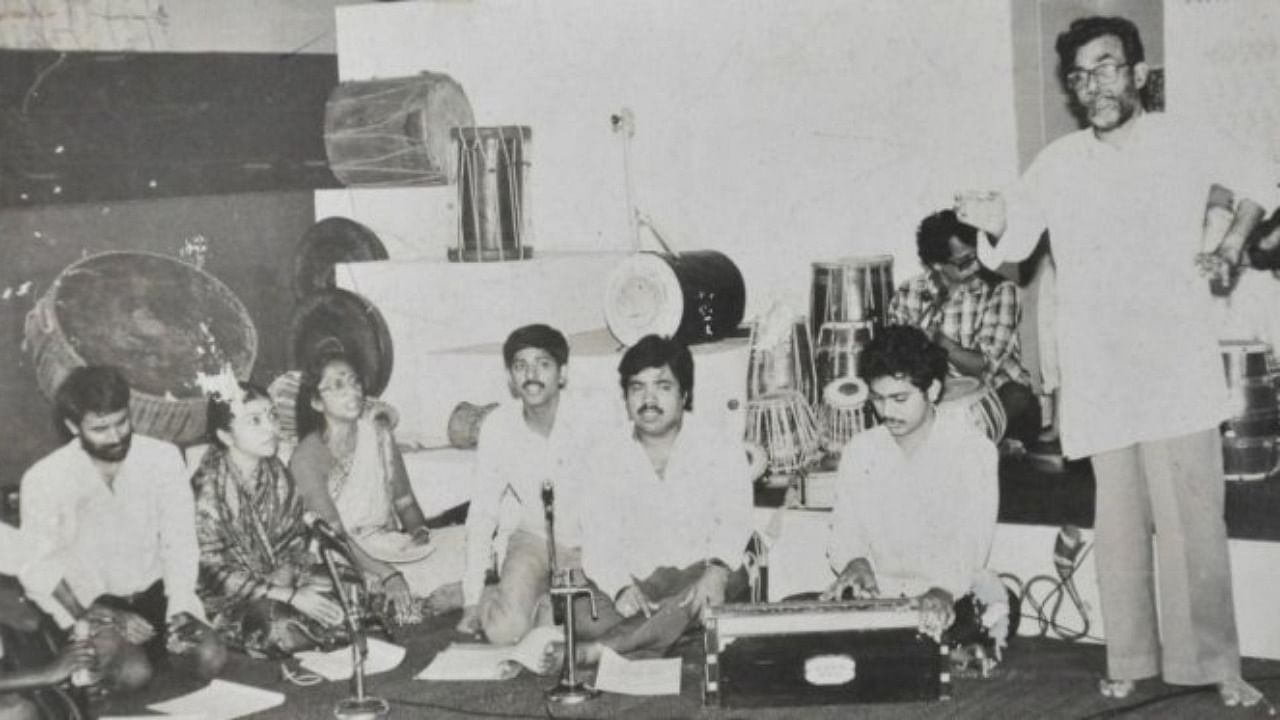

The actor lay quite still on the stage. He was playing dead. The audience, though, would have none of it. Shouts of encore rent the air.
But it was neither the actor nor the character that evoked this reaction — it was the song he had sung before his ‘death’. The audience wanted to hear the song all over again. So the ‘dead’ person arose, sang once more and promptly dropped dead again.
Senior theatre person, well-known rangagayaki and actress Kalpana Naganath tells us that as implausible as this may sound, such tragi-comic incidents used to happen often on stage due to the sheer popularity of rangageethegalu (theatre songs/music) in Kannada theatre.
“There were times when people used to throng to a particular play just to listen to its songs,” Kalpana, who is a treasure trove of knowledge about theatre music, recalls.
A rich tradition
The tradition of rangageethegalu, whether in the ‘company theatre’ (professional theatre troupes) or the modern/experimental theatre (led more by ideas and directors), is as old as it is rich and varied. Unfortunately, there is neither enough recognition nor appreciation of its enormous contribution to the growth of Karnataka’s theatre scene over the decades.
Nonagenarian T K Ramachandra, a retired principal and senior playwright who has also worked extensively in children's theatre, recalls how it was the doyen of Kannada theatre A V Varadachar who made music, especially classical singing, an integral part of plays.
"Between 1904 and 1926, when Varadachar's theatre troupe Ratnavalli Nataka Company used to perform in every nook and corner of the state, plays like Manmatha Vijaya and Nirupama had some fantastic music woven seamlessly into the plot… I recall there used to be a pit in front of the stage where one meshtru (artiste) used to play the leg harmonium. There would be a tabla player, of course…it was almost like a live band and the singer-actors used to hold court. Some plays had as many as 60 songs!"
“It also helped that the majority of ‘company plays’ were mythological — the plot naturally lent itself to be prodded ahead with music,” he adds.
The legacy then continued with pioneering theatre director Gubbi Veeranna whose company plays like Sadarame and Yechamma Nayaka had songs that were as much of a cultural phenomenon as Bollywood numbers are today.
Legendary actor Dr Rajkumar had, in fact, in several interviews, attributed his singing skills to the training he underwent while he was with the Gubbi Nataka Company. Rajkumar might, arguably, have been its most famous name, but company theatre has also given us talents like B Jayashree and the late Paramasivan, both of whom have sung countless rangageethegalu, apart from being stellar artistes in their own right.
However, it was with the almost pan-India theatre renaissance of the 1960s-70s that music in plays underwent a dramatic transformation, says popular singer-actor M D Pallavi, who herself has not only sung live on stage in several productions but has also recorded several theatre numbers.
With the advent of directors like Girish Karnad, Chandrashekhara Kambara and B V Karanth, Kannada theatre saw some fantastic experimentations and each of these stalwarts used music in a different way.
Kalpana believes it was B V Karanth who was largely responsible for infusing new energy into theatre music. “The way he wove in chorus singing, instrumentation, folk, Hindustani, Carnatic… every genre of music into theatre was astonishing,” she elaborates.
“Under someone like meshtru (B V Karanth), singers learnt to be actors too — each line of every song had its own cadence and emotion; for instance, if there was a song that spoke of the keelukudure (rocking horse), the singer had to enact its rhythm and sounds tonally as well as sync with the actor on stage.”
Pallavi adds though music is still very much a part of productions, it has become more diverse and innovative. “The crucial difference is now there is specific attention paid to sound design and music becomes an organic part of the holistic theatre soundscape. Music will always remain an integral part of storytelling in our culture; just that now we play with a lot of possibilities — whether it is pre-recorded, live singing or even a hybrid of both."
Revival efforts
There have been efforts to revive theatre music by groups like Bengaluru Nagara Kalavidaru (Benaka) and more recently by non-profit organisations like Aviratha, a multi-faceted group focussed on socio-cultural betterment, especially among underprivileged children.
Satheesh Gowda, one of its founders, says the pandemic has put paid to their efforts but before it struck, they had conducted several workshops and musical programmes to introduce children to folk and theatre music. "We had organised specific programmes on B V Karanth, K Y Narayanaswamy and Gopala Vajpayee's songs… kids used to love these sessions, but now nothing is possible," he rues.
Ramesh Gururajarao, who was part of Kannada amateur theatre for a couple of decades as a singer and now works in a software firm, tells us about how rangageethegalu were adapted into street plays. “We used to travel from village to village performing plays on issues like cancer awareness — these were mostly song-based and we have easily had more than 500 such performances,” he narrates.
Ramesh was the lead singer in several plays, including Manteswamy Kathaprasanga, which incorporated Neelagara folk singing in its plot. Scattered efforts have also been made to document some of the popular songs, notably by B V Karanth and C Ashwath in his Nesara Nodu audio collections, he adds.
It is true that rangageethegalu might not be popular enough today for actors to arise from the dead to sing an encore, but for those who have lived and experienced the magic of theatre music, hearing even a snatch of a forgotten song is enough to feel alive.